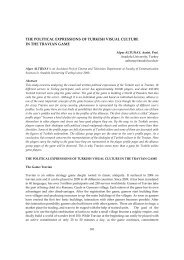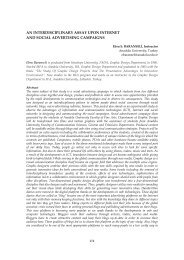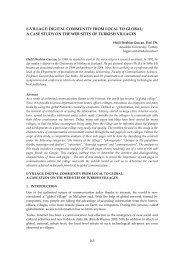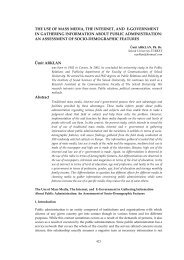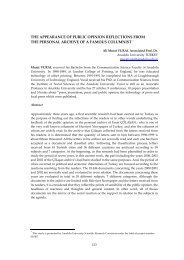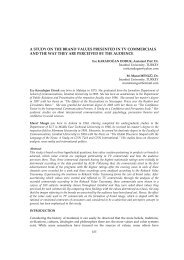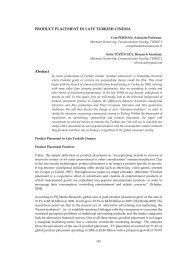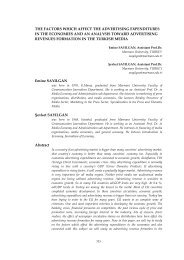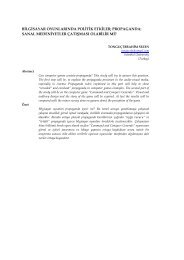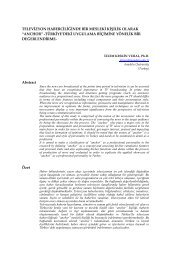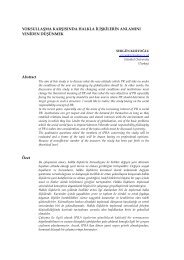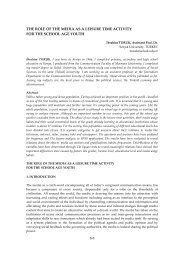the evaluation of turkish consumers' attitudes towards foreign products
the evaluation of turkish consumers' attitudes towards foreign products
the evaluation of turkish consumers' attitudes towards foreign products
You also want an ePaper? Increase the reach of your titles
YUMPU automatically turns print PDFs into web optimized ePapers that Google loves.
THE EVALUATION OF TURKISH CONSUMERS’ ATTITUDES<br />
TOWARDS FOREIGN PRODUCTS<br />
Products are produced in “places” or any place ranging from a city to a state; in a<br />
country, in an area, in a continent or in <strong>the</strong> world as “global” <strong>products</strong>. This information<br />
about <strong>the</strong> place where <strong>the</strong> product is produced is called as country origin. Actually, a<br />
product or brand cannot be thought apart from <strong>the</strong> place where it was produced, in o<strong>the</strong>r<br />
words <strong>the</strong> country origin.<br />
The social changes and developments and economic changes in world history have also<br />
changed country origin effect and description. For example, <strong>the</strong> appearance <strong>of</strong> local<br />
cultures, <strong>the</strong> increase in <strong>the</strong> facilities <strong>of</strong> transportation, and <strong>the</strong> most importantly <strong>the</strong><br />
increase in <strong>the</strong> easiness <strong>of</strong> obtaining <strong>the</strong> desired information have also increased <strong>the</strong> effect<br />
<strong>of</strong> knowing about <strong>the</strong> country origin on consumption and communication studies.<br />
Consumers know about what <strong>products</strong> are better produced in which areas no more, and<br />
this case affects many factors ranging from brand preference to <strong>the</strong> money to be paid for<br />
a certain product.<br />
Products are not necessarily made in “countries”. They are made in “places”, or<br />
geographic origins, which can be anything from a city to a state or province, a country, a<br />
region, a continent-or <strong>the</strong> world, in <strong>the</strong> case <strong>of</strong> “global” <strong>products</strong>. Fur<strong>the</strong>r, unless viewed<br />
in strictly legal terms, “made-in” can mean manufactured-in but also assembled-,<br />
designed-, or invented-in, made by a producer whose domicile is-in, and <strong>of</strong>ten, wanting<br />
to lool like it was made-in . Lastly, “buyers and sellers” can be anything from industrial<br />
and consumer users <strong>of</strong> <strong>products</strong> to national governments courting each o<strong>the</strong>r in <strong>the</strong> hope<br />
<strong>of</strong> establishing closer trade relations. Since <strong>the</strong> “origin” images <strong>of</strong> “<strong>products</strong>” can have so<br />
many facets, it is no surprise that <strong>the</strong>y have been <strong>the</strong> object <strong>of</strong> study in disciplines ranging<br />
from political science to cultural anthropology and urban geography (Papadopoulos,<br />
Heslop, 1993).<br />
When we look from advertisers’ and advertising communicators’ point <strong>of</strong> view, it<br />
becomes an important datum to know about under which conditions <strong>the</strong> effect <strong>of</strong> country<br />
origin turns out to be an important factor. For instance, when a new communication<br />
strategy <strong>towards</strong> <strong>products</strong> or services is developed, <strong>the</strong> effect <strong>of</strong> country origin must be<br />
taken into consideration.<br />
The basic factors affecting <strong>the</strong> country origin<br />
When <strong>the</strong> literature in <strong>the</strong> field <strong>of</strong> country origin is carefully studied, it is seen that <strong>the</strong>re<br />
are six basic factors affecting <strong>the</strong> country origin effect. The studies carried out in <strong>the</strong> field<br />
can be classified depending on this; as country image and its characteristics, <strong>attitudes</strong><br />
<strong>towards</strong> trademarks, product knowledge/product properties, culture, consumer<br />
characteristics and consumer ethnocentrism.<br />
When country image and characteristics are mentioned, <strong>the</strong> first thing that we recall is<br />
that each country has been identified with different icons including each country’s<br />
historical culture and has created a country image being labeled as a trademark. Many<br />
studies having been carried out so far, have revealed that country image is an important<br />
factor affecting consumers’ choices in purchasing in today’s global market. Image is<br />
defined as “mental picture being formed as a result <strong>of</strong> a process <strong>of</strong> being informed”. With<br />
a clearer expression, it means evaluating <strong>the</strong> obtained knowledge and data, ranging from<br />
376



